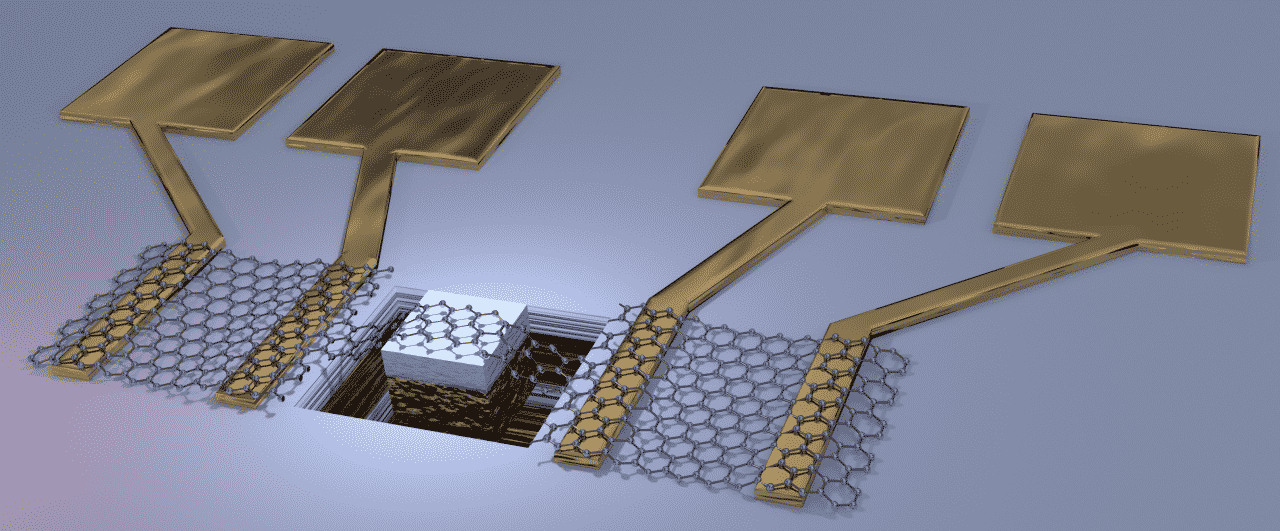
An international team from the Royal Institute of Technology (KTH) in Stockholm and the Aachen Graphene & 2D Materials Centers recently developed the world’s smallest accelerometer. This might prove to be a sensational breakthrough in sensor and navigation technology. The team used the exceptional mechanical and conductive properties of graphene as a basis. Furthermore, the ultra-thin layer structure of the material also plays a role in further developments.

“The future for very small accelerometers is promising,” explains Xuge Fan from the Institute for Micro- and Nanosystems at KTH Stockholm. “These types of sensors will be able to improve navigation in mobile phones, be used as pedometers and in mobile games, and be used in cardiovascular monitoring systems. They can also be used as the basis for motion-capture wearables which capture the smallest movements of the human body.” And Fan adds: ” These NEMS transducers can also be used for determining the mechanical and electromechanical properties of graphene.”
After MEMS, NEMS is next
While microelectromechanical systems (MEMS) have formed an important basis for innovations in sensor and medical technology for several decades already, nanoelectromechanical systems – NEMS for short – are now entering into the next stage of development.

Professor Max Lemme, holder of the Chair of Electronic Components at RWTH Aachen University and Managing Director of AMO GmbH, explains further:
“The initial idea for sensors made of graphene membranes came to us around 2012, and the preliminary results were published in the following years. The idea for this specific accelerometer was then developed on the basis of these results in 2015 or thereabouts.”
And he adds …
“Our cooperation with KTH in recent years has already proven the potential of graphene membranes for pressure and hall effect sensors and microphones. The range of applications is now being extended to include acceleration sensors.“
A few more steps towards production
Lemme is optimistic that the material will be ready for the market within a few years:
“We are working on industry-compatible production and methods for integration in order to achieve this.“
The professor is also pleased with the fine body of work being done at the Aachen Graphene & 2D Materials Center – a consortium involving RWTH Aachen University and AMO GmbH:
„Research into graphene and two-dimensional materials is characterized by the iterative feedback of basic and applied research. For example, we try to translate recently discovered material properties into applications straightaway – this is what makes our work so exciting.“
Nevertheless, Lemme cautions against too much euphoria:
“The sensor is a prototype. Of course, we have tested and proven that it can be replicated in the laboratory, but many steps are still required for manufacture.”
It is still not known when a sensor developed by the consortium will actually be launched onto the market:
“That all depends not only on technical improvements but also on commercial considerations. Moreover, the graphene technology must be brought to a production-ready state, regardless of the application.”
The team published an overview of this issue in the journal Nature Materials in May. Lemme also outlined the next research steps as follows:
“As part of the Graphene flagship project, we want to develop a pilot line for prototype production together with partners in Belgium, Finland, Spain, England and Germany. This would enable us and our industrial partners to bring graphene technology up to a substantially higher level of technological sophistication. This is essential in order to be able to incorporate graphene into products in nanoelectronics, photonics and sensor technology.”
Ongoing work has recently been published in the journal Nature Electronics.
The research was funded by the European Research Council through the Starting Grants M&M’s (277879) and InteGraDe (307311), the Swedish Research Council (GEMS, 2015-05112), the China Scholarship Council CSC (Scholarship Grant), the German Federal Ministry of Education and Research (NanoGraM, BMBF, 03XP0006C), the German Research Foundation (DFG, LE 2440/1-2) and the European Commission (Graphene Flagship, 785219).
This article may also be of interest to you:
Start-up of the Day: fashioning graphene out of food waste

